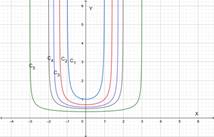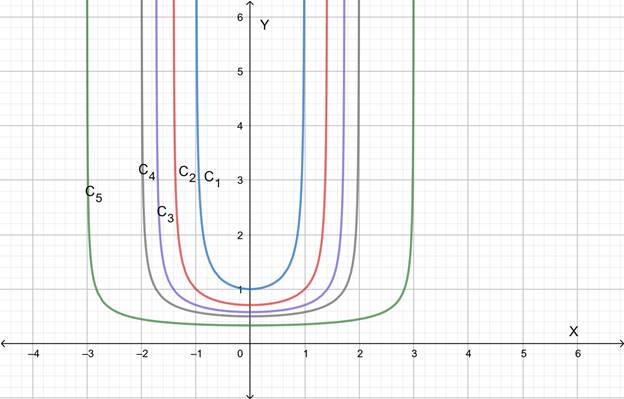
a.
To comment : On the graph of the solution of the
a.
Answer to Problem 8E
When
When
Explanation of Solution
Given information :
Formula used :
Calculation :
Integrating we get,
Now,
i.e. When
Therefore, when we say
i.e. When
b.
To verify : All the members of the family of the function
b.
Explanation of Solution
Given information :
Differential equation:
Formula used :
Calculation :
Differentiating both sides with respect to
So,
c.
To graph : The several member of the family of the solution on the common screen. And identify whether the graph confirm the conclusion of the part (a) or not.
c.
Answer to Problem 8E

Yes, the graphs confirm the conclusion of part (a).
Explanation of Solution
Given information :
Graph :

Interpretation :
The graphs are drawn for different value of
Yes, the graphs confirm the conclusion of part (a).
d.
To find : A solution of a initial value problem.
d.
Answer to Problem 8E
Explanation of Solution
Given information :
Differential equation:
Concept used :
If
Calculation :
We have in part (b)
Now,
Then,
i.e.
Chapter 7 Solutions
Single Variable Calculus: Concepts and Contexts, Enhanced Edition
 Calculus: Early TranscendentalsCalculusISBN:9781285741550Author:James StewartPublisher:Cengage Learning
Calculus: Early TranscendentalsCalculusISBN:9781285741550Author:James StewartPublisher:Cengage Learning Thomas' Calculus (14th Edition)CalculusISBN:9780134438986Author:Joel R. Hass, Christopher E. Heil, Maurice D. WeirPublisher:PEARSON
Thomas' Calculus (14th Edition)CalculusISBN:9780134438986Author:Joel R. Hass, Christopher E. Heil, Maurice D. WeirPublisher:PEARSON Calculus: Early Transcendentals (3rd Edition)CalculusISBN:9780134763644Author:William L. Briggs, Lyle Cochran, Bernard Gillett, Eric SchulzPublisher:PEARSON
Calculus: Early Transcendentals (3rd Edition)CalculusISBN:9780134763644Author:William L. Briggs, Lyle Cochran, Bernard Gillett, Eric SchulzPublisher:PEARSON Calculus: Early TranscendentalsCalculusISBN:9781319050740Author:Jon Rogawski, Colin Adams, Robert FranzosaPublisher:W. H. Freeman
Calculus: Early TranscendentalsCalculusISBN:9781319050740Author:Jon Rogawski, Colin Adams, Robert FranzosaPublisher:W. H. Freeman
 Calculus: Early Transcendental FunctionsCalculusISBN:9781337552516Author:Ron Larson, Bruce H. EdwardsPublisher:Cengage Learning
Calculus: Early Transcendental FunctionsCalculusISBN:9781337552516Author:Ron Larson, Bruce H. EdwardsPublisher:Cengage Learning





